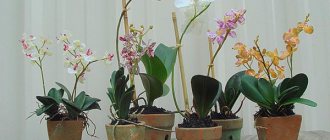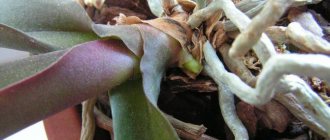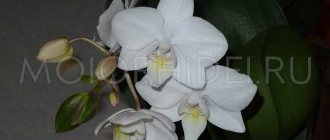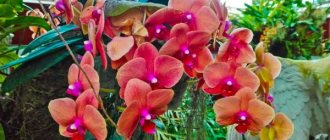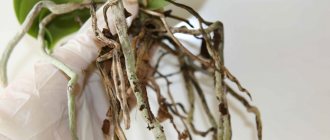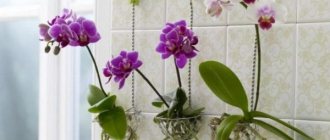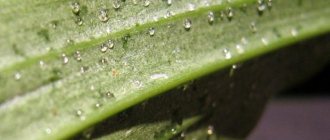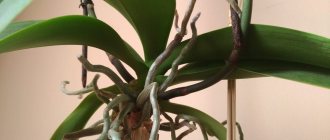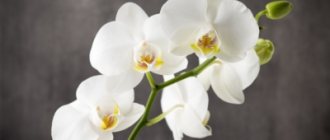02/20/2019 Michur Ivanov Garden and vegetable garden
Orchid is one of the most ancient crops on Earth. Plants of this species appeared approximately 100 million years ago. Among horsetails and ferns, they became the first flowering crop. It is noteworthy that the appearance and structure of the orchid has been preserved since those ancient times. The unusual shape of the inflorescences, strong foliage and aerial root system have reached modern times. In this article we will look at the features and structure of an orchid.
General description of the species
Orchids are one of the most numerous families in the plant world. Most of it consists of perennial grasses. Shrubs and woody vines are more rare. An orchid can have a wide variety of sizes. The smallest member of the family has a height of only a few centimeters, and the largest exceeds 35 meters.
Most representatives of this culture are epiphytes. They grow on the trunks of other plants, using them as support. It is noteworthy that such orchids are not parasites. This type of plant does not care about the soil, they receive more sunlight and are less exposed to herbivores.
The roots of this ancient plant are one of its most important organs. They perform a number of functions necessary for the normal existence of an orchid. First of all, they allow the plant stems to anchor in the substrate. Thanks to this they are in a vertical position. The second important point is the participation of the root system in the process of photosynthesis. Due to the structure of orchids, they share this role with foliage. The third interesting feature of the roots of these plants is their ability to absorb moisture in the air and the bark of the crops on which the orchid grows.
Another significantly common type of orchids is called lithophytes. Compared to epiphytes, they are few in number. As a rule, such orchids grow in rocky areas. The third group is terrestrial species. They are the second in number of species.
The trunk of an orchid can have a variety of shapes. It can be short, long, erect and creeping. It depends on the type of orchid plant, structure and its species characteristics. The culture has simple alternate leaves. The color of flowers can be very diverse, as well as their size. Experts distinguish two types of inflorescences in an orchid: a simple spike with a single arrangement of flowers and a raceme with many flowers growing along the stem.
Deviations in color
Of course, all deviations from the green tint are not the norm for orchids.
- Yellow color may indicate wilting, drying of foliage, as well as improper care and overdose of mineral fertilizers.
- Purple color - leaves are damaged by sunlight. Overheating in intense light or thermal burns can cause a similar effect.
- A reddish, brown tint may appear as a result of excess lighting.
- But the black, dark brown color indicates that the orchid is susceptible to infectious diseases, in particular rot.
Types of branches
The numerous orchid family can be divided according to the type of branching into two huge groups. The first type, developing horizontally but producing several stems that grow vertically, is called sympodial. This variety of orchids includes Cattleya, Bulbophyllum, Oncidium, Encyclia and many others. The stem of these plants grows horizontally and in most cases is located under the substrate. It releases a large number of vertically growing shoots to the surface. Flowers, bulbs and other parts of the crop, in turn, develop on them. It is noteworthy that such an orchid has a kind of main horizontal shoot. It is called a rhizome.
The second type of orchids are plants that have a monopodial shoot. Unlike the sympodial one, it has one growth point and grows vertically. The most prominent representatives of this species are: Vanda, Erangis, Phalaenopsis and Vanilla. But besides them, there are many more orchids of this type that grow in the wild. The structure of the orchid provides for a single main shoot on which the crown bud is located. New pairs of leaves grow from it every year. Between the leaves there are axils where the generative buds are located. They subsequently develop into an aerial root system and flower stalks. It is noteworthy that the stem itself can also have buds. However, they are vegetative. Their role is to develop new shoots if the main stem dies.
Orchid leaf structure
The foliage of a plant can have a wide variety of shapes and sizes. It depends on the type. For example, monopodial orchids have large leaves and a dense structure. Under natural conditions, they act as a reservoir of useful microelements and moisture. Leaves are formed annually from shoots. Each shoot develops into two leaves. They grow strictly opposite each other. Experts call them pairs. It is noteworthy that the distance between leaves in pairs can be very different. In some cases it can be several millimeters, while in others this gap reaches a meter or more. This feature depends on the type of orchid.
In turn, in sympodial types, the bulbs are responsible for the accumulation of nutrients. They are small formations located at the base of the shoot. In this regard, sympodial orchids have small, thin leaves of a narrow shape. Depending on the variety, they can be small scaly or long whip-like.
Stem
An orchid does not have a stem in the full sense of the word. For her, this role is played by escape. At the same time, the structure of the orchid shoot contributes to the rapid development of the culture. In monopodial species it is vertical, with branches and leaves located on it. Sympodial orchids have vertical shoots with rhizome branches or, as it is also called, rhizomes. This is the supporting part of the plant, its stem. With the help of epiphytic roots, the rhizome is attached to the substrate. It is noteworthy that the stems of this crop can be either short or very long. In their natural environment, plants of this family, which have a long trunk, are attached to trees by aerial roots. When growing an orchid at home, a support is placed in the flower pot.
Leaf colors
Pale green
Greenery turns pale green when there is a lack of sunlight . In order for them to acquire a shade corresponding to their grade, it is transferred to a brighter room with diffused sunlight.
After a certain time, the green mass will return to its normal color .
It is also worth feeding with fertilizer containing a large proportion of nitrogen substances. It is worth feeding 2-3 times in order to:
- Do not disrupt metabolism;
- Do not provoke violent growth of leaf mass to the detriment of flowering.
Purple
The plates turn purple when they burn in direct sunlight. Overheating can also contribute to this.
to remove the container with the plant from the southern window sill in the summer . Since even windows covered with white paper may not save the flower from overheating.
It is not recommended to move it to the north side, as a rapid change in cultivation conditions can lead to the death of the flower .
Striped
First of all, we need to reassure a novice florist , who for the first time saw a flower with variegated greenery - this is normal, it’s just that the purchased orchid belongs to a variety that has leaves with colored splashes.
The striped leaves of the orchid were bred artificially.
The reason for the appearance is the efforts of breeders in many countries, since these varieties were bred artificially . Their flowers are poorer than those of specimens with green foliage. But they take advantage of the beauty of their vegetative part.
Aerial roots of an orchid
These organs are the most unique part of the plant. The orchid is an epiphyte. Such plants attach to other crops using shoots, but are not parasites. They do not suck out nutrients, but simply rest on the plant. Orchids need this, for example, in order to get along tree branches to more illuminated places. The most striking representative among epiphytes is the Phalaenopsis orchid, the structure and size of which allows it to be grown at home. It is noteworthy that the plants do not take root in the soil. They obtain all the substances necessary for normal development through photosynthesis. They are able to take moisture directly from the air. It is to perform these functions that they need roots located on the surface. In shape they are long and thick shoots. The outer layer of the roots consists of velamen. It is a kind of spongy tissue. With its help, the roots absorb moisture in the air. In addition, this coating plays a protective role.
Bulba
This interesting name was given to special formations that are found only in sympodial orchids. They are a thick, powerful shoot that acts as a reservoir for moisture and nutrients. Moreover, the word “bulba” itself translated from Latin means “onion”. It is noteworthy that, in addition to such formation, there are also so-called pseudobulbs. They are the same growths, performing the same role, but having a different appearance. Pseudobulbs can be ovoid, oval or even conical. However, both types have a common name - tuberidium. They appear from vegetative shoots of the rhizome. In fact, bulbs are shoots of a special shape. They also form buds and form leaves.
Diseases
Rot
Many diseases lead to a complete or partial change in the color of the leaves; at first they may acquire a reddish color, and then completely turn black. This indicates the presence of rot. To get rid of this disease, you need to carefully remove the affected areas.
Anthracnose
If you notice clear brown spots on the leaves of your plant, it could be Anthracnose. This disease can appear due to high humidity; areas with stains must be removed and the sections treated with charcoal .
Powdery mildew
Small fuzzy white spots can indicate the presence of a disease such as powdery mildew. If this disease is not treated, the plant may die. The cause of this disease can be high humidity and hot temperatures. This disease can be treated with a drug such as Skor or Topsin.
An orchid is an exotic plant that requires special care. By its leaves you can understand the general condition; if they are dense and pale green in color, then the plant is healthy. And if they change color or spots appear on them, this indicates the presence of a disease.
If you find an error, please select a piece of text and press Ctrl+Enter.
Orchid flowers
With all its variety of shapes and colors, the structure of an orchid flower is quite simple. Its distinctive feature is central symmetry, that is, six parts are arranged in two circles. The outer circle has three colored sepals. They, in turn, alternate with the petals of the inner circle. In the center is the labellum. The so-called “lip”. It is noteworthy that only the orchid family has this part of the flower. The “lip” acts as a landing site for insects that pollinate the plant. The color and shape of the labellum can be very different. This directly depends on the type of orchid. Orchid flowers can have different shapes and sizes from 1 to 25 centimeters.
Peduncle structure
The peduncle of an orchid is a shoot on which flowers are formed. In turn, it grows from the axil between the trunk and leaves of the plant. The peduncle changes annually. At home, it grows in autumn or spring. If the formation of a peduncle does not occur, this may mean that the plant does not have enough light. As a rule, the problem is eliminated by moving to a brighter place. When the flowers fall, the peduncle dries out. Experts recommend removing it and then drying the sections.
Orchids are not only one of the oldest plant families on the planet, but also one of the most beautiful. This culture can add its own flavor to any interior, and knowledge of the structure of the plant will allow you to provide proper care for it.
Source: fb.ru
plants, photography
Care
The orchid is native to tropical forests with a humid and hot climate. In our latitudes, orchids need additional care, otherwise problems with the beauty’s well-being will immediately arise.
- Wipe the leaves regularly with a damp cloth to remove dust.
- It is advisable to spray the flower 5 times a day. Avoid the procedure during the flowering period.
- Use clean, filtered water at a temperature of 35-40ºС.
- Humidity within 50-60%. Be sure to regularly ventilate the room.
- The plant loves a warm shower, but water should not stagnate in the leaf axils, otherwise there is a risk of disease.
- You should not place the pot in a window with bright sunlight; the rays can leave thermal burns on the leaves.
- Lighting is required diffused, with a daylight duration of 14 hours.
- For active growth and rich leaf color, it is recommended to use nitrogen-based fertilizers.
- Visually inspect foliage weekly for insect damage.
